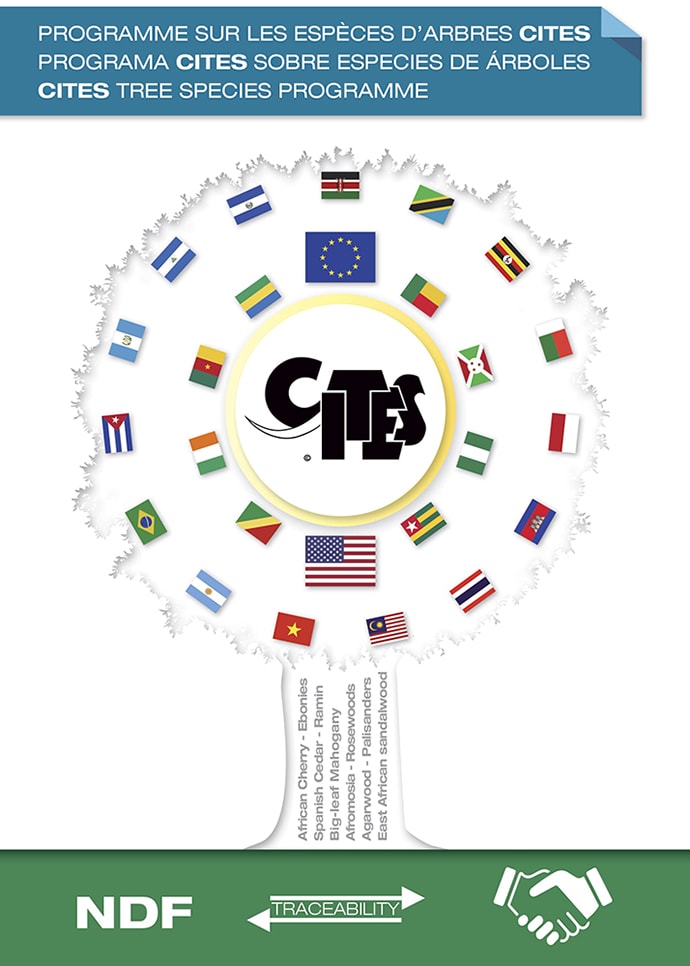
Background
Concerned that the long-term survival, of commercially valuable tree species may be threatened by over-exploitation, the CITES Conference of the Parties has agreed to include more than 900 tree species under the CITES Appendices. Products of these tree species may only be exported if the Scientific Authority of that Party has advised that the export of the specimens will not be detrimental to the survival of the species in the wild.
To that end, the CITES Tree Species Programme aims to provide direct financial assistance to Parties in taking conservation and management measures to ensure that their trade in timber, bark, extracts and other products from CITES-listed tree species is sustainable, legal and traceable.
Expected outcomes of the programme
- Ensure the sustainable management of rare tree species and their products;
- Contribute to legal, traceable, and fair trade in products from CITES tree species;
- Improve and strengthen forest governance, policies for forest management, and enforcement capacity and ensure benefit from long-term; and
- Contribute to the rural development in often remote areas, sustainable economic growth at a country level, a healthy private sector, and long-term poverty alleviation.
Geographical scope
Considering efforts to assist Parties to implement the Convention for CITES listed tree species, the financial support will be available for the implementation of activities in three target CITES regions: Africa, Asia, and Central and South American and the Caribbean.
More about RegionsTaxonomic scope
- Asia: Dalbergia cochichiniensis, Pterocarpus sanctalinus, Taxus spp., Aquilaria spp., Gyrinops spp., Gonystylus spp.
- Africa: Diospyros spp. (Madagascar), Dalbergia spp. (Madagascar), Pericopsis elata, Osyris lanceolata, Pterocarpus erinaceus, Prunus africana, Guibourtia demeusei; G. pellegriniana; G. tessmsnnii
- Central and South America and the Caribbean: Swietenia spp. (3 species), Dalbergia spp. (and notably Dalbergia nigra, D. retusa, D. granadillo, D. stevensonii, D. calycina, D. tucurensis, D. cubilquitzensis, D. glomerate, D. melanocardium, D. calderonii, D. retusa var cuscatlanica, D. funera), Platymiscium dimorphandrum, Platymiscium yucatanum, Enterolobium cyclocarpum, Lonchocarpus castilloi, Astronium graveolens, Aniba rosaedora, Bulnesia sarmientoi, Guaiacum spp.
Core areas of work
- formulation of non-detriment findings;
- marking and traceability;
- tree products identification;
- capacity building – governance.
Advisory Committee
The Advisory Committee ensures strategic advice and guidance to the programme, through advice on programme implementation, proposal applications, annual progress report.
Regional Support
To facilitate a smooth implementation of the CITES Tree Species Programme, three Regional Coordinators have been appointed, whose tasks include:
- Assist with the formulation of national project needs and priorities;
- Assist with the design of projects/activities;
- Monitor the progress of the implementation of approved activities and budgeting by implementing agencies;
- Assist in convening meetings as relevant;
- Provide technical advice to avoid duplication of effort; and
- Interact with other projects and programmes of the CITES Secretariat as requested
CITES Tree Species Programme Team
Ms. Sofie H. Flensborg
Coordinator of CITES Tree Species Programme
e-mail: sofie.flensborg@cites.org
Ms. Sofia R. Hirakuri
Regional Coordinator for Central and South America and the Caribbean
e-mail: sofia.hirakuri@un.org


